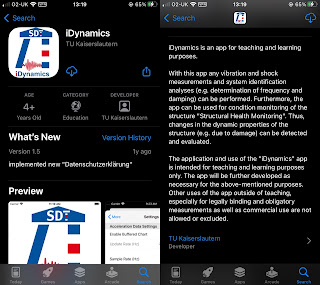A rudimentary study of dynamic loading
I currently live in an end-of-terrace Victorian home which runs parallel to a narrow, busy road. I am somewhat concerned about subsidence as the constant vibrations from cars, lorries and refuse vehicles moving immediately adjacent to the home have (potentially) caused minor movement in the soil beneath the shallow foundations. Traffic-induced ground vibrations are a frequent concern to geotechnical and geological engineers as vibrations travel through the subsoil and cause damage to immediate substructures, ranging from cosmetic plaster crack(s) to more serious structural issues.
 |
| Example of dynamic loading on a building |
Traffic-induced vibration is caused by the interaction between the dynamic forces produced by vehicles and the road. Dynamic loading can be loosely defined as the constantly varying load of a vehicle due to internal and external factors while moving along a road. The dynamic forces on roads that induce vibrations are generally three types:
- The impact force of the tyres, which produce vibrations of 800–1500 Hz.
- The impact force due to unsuspended mass of the vehicle, which produces vibrations of frequencies 10–15 Hz.
- The impact force due to suspended mass of the vehicle, which produces vibrations 1–2 Hz.
From what I can understand of related geology literature, the contribution of tyre impact forces to ground vibration is generally considered negligible. Thus, the frequency content of traffic-induced ground vibration generally lies between 2–15 Hz.
 |
| Types of loads exerted on a road surface |
Different vehicles cause different magnitudes of vibration. Vehicle characteristics including its weight and suspension have an effect on the magnitude of ground vibration it induces. Additionally, the speed of the vehicle also affects the magnitude of ground vibration. The other major parameter is road surface. The rougher the road surface, the higher the vibration magnitude will be.
Relatedly, accurate measurement of vibrations is a necessary step to determine their potential effect on local structures. While there are a number of smartphone apps that can be used in professional vibration measurement, there are hardly any that accurately measure small amplitude ground vibrations such as traffic-induced ground vibration.
 |
| iDynamics app available in Iphone App Store |
I recently downloaded a smart phone application called “iDynamics” which was developed to take advantage of built-in accelerometers of smart devices for the acquisition vibration of flexible systems. According to the app, it measures vibration and acceleration amplitudes in three axes and detects frequency of vibration. The app calculates velocity and displacement amplitudes and acceleration RMS (Root Mean Square).
I placed the phone perpendicular to the direction of traffic, and varied the measurement at 1 m and 2 m distances from the passing vehicles (behind a load-bearing wall). My results were severely limited because I was unable to place the phone below the ground surface, and therefore had to rest the phone on the ground surface. An ideal depth would have been 50 centimetres below in the crawlspace.
 |
| Representation of phone placement |
I left the phone for an hour and was able to correlate recorded data with our domestic CCTV cameras to observe what vehicles passed and sync them with varying triaxial vibration amplitude recordings. Rudimentary analysis of the data showed that vibration amplitude increases with vehicle speed (hard to gauge accurately on CCTV) and weight. Passing Veolia refuse trucks caused the greatest vibration amplitudes while mopeds caused an infinitesimal disturbance (other than sound). One interesting observation was that vibration amplitude increased significantly when vehicles mounted (or dismounted) the pavement. Vibration amplitude also decreased with distance.
 |
| Screenshot depiction of results of phone recordings |
Built-in accelerometers of smart phones can be an easy and quick means of semi-professional traffic-induced ground vibration acquisition. They offer primitive insights into the effects of dynamic loading due to traffic-induced ground vibrations. Nevertheless any serious structural reports on subsidence caused by accumulative vibrations to soil substructure should be checked with professional devices and software. Nevertheless this app provided meaningful data and demonstrated that the exterior load-bearing wall immediately adjacent to the road was exposed to fair levels of vibration (compared to baseline). This has cemented my intentions to underpin the home with traditional underpinning or polymer resin injections.


Comments
Post a Comment